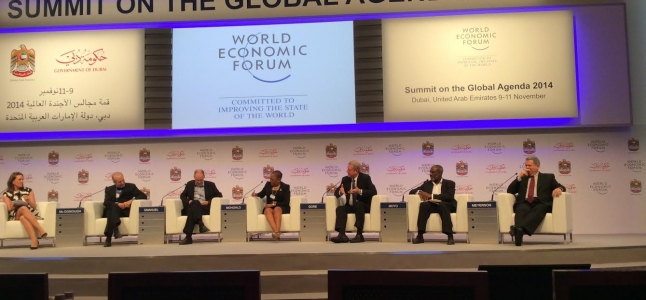This week I attended the Summit on the Global Agenda of the World Economic Forum (WEF). It’s an annual event – my fourth – that brings together over 80 Global Agenda Councils, each built around global challenges ranging from cities, unemployment, finance, and data for development, to the automotive industry, justice and specific regions, like Africa. I was there as vice-chair of the Justice Council and member of the meta-council on New Architecture of Global Governance.
The structure of the Global Agenda Councils is itself a very innovative piece of global governance. Klaus Schwab calls it ‘the world’s largest interconnected brain trust’ and he’s right. Something like this would not have come from the UN system. Eighty times fifteen leading experts on a global challenge are brought together to produce results that push thinking and doing to new levels.
The Councils are given an enormous amount of freedom. It is informal, under Chatham House rules, with room for creativity, the emergence of new synergies, and even failure. Many Council members are people from governments, businesses, and international organisations. They sit with top scientists; think tankers, and civil society representatives.
The structure does not ‘adopt’ anything: no voting on treaties, laws, or resolutions. There are no formal procedures and there is little to no hierarchy. The support structure consists of one physical meeting a year, as many Skypes or telephone meetings as each Council wants, a Council manager to hold things together, and a web-based tool called Toplink – that allows people to find each other, ask questions, and inform each other about results.
And it does produce them. An example: the Council on Africa and the Council on Tourism were able to do something about the challenge that it was easier for Europeans to travel through Africa than for Africans. They mobilised politicians, customs officials, industry leaders and NGO representatives and were able to put in place a Schengen-type visa arrangement for groups of African countries. It is so successful that it is being copied in Asia. The WEF only partially gets credit for this: in the newspaper you would have read: “The governments of X, Y, and Z have agreed to abolish visa requirements, etc.”
Each year, all Council members fill in a questionnaire on the biggest global challenges they see for the coming year. The responses become the Global Agenda Report, which feeds into annual Davos meeting of the WEF. The top 10 trends for the coming year, in order of seriousness, are: deepening income equality, persistent jobless growth, lack of leadership, rising geostrategic competition, weakening representative democracy, rising pollution in the developing world, increasing occurrence of extreme weather events, intensifying nationalism, increasing water stress, and growing importance of health the economy.
The Global Leadership Index – also part of the report – shows that non-profit and charitable organisations and business continue to get more leadership trust than government. Current global governance structures are still seen as effective by around 50% of respondents, but a big majority of respondents also feel they need renewal. Interesting: local, national and regional governance (and not international) are expected to be most successful at dealing with the current challenges.
We seem to be quite effective – this Summit and other initiatives such as the International Panel on climate Change show – at recognising the challenges. In medical terms: diagnosis. What remains extremely hard is what to do next. The gift of seeing that the world now clearly comes with a curse: we don’t have the body parts to be able to handle what we can now see. As one of the Summit participants worded it: “We need systems that can handle quantum mechanical policymaking and management.” Policymaking and management at multiple levels: local, national, regional, international, public, private, thematic and sectoral, all at the same time but also all separate from each other. Systems that can process and act on massive amounts of data and that can standardise but also customise to the needs of each village and citizen.
It is hard to imagine what such a system will look like. Just as it was hard for small bands of human living in clans 3000 years ago to imagine how a huge state like the US would be run. The road from those clans to the US was incremental and filled with potholes. There was no blue print and there won’t be one now. We can only hope that our greatly enhanced capacity for diagnosis will push us to think harder and faster about governance innovation.
And what about justice? Whatever happens, it remains a pivotal foundation for whatever governance systems emerge out of the challenges the world now faces. In fact, it is so pivotal that – as HiiL has been saying for many years – the monopoly of lawyers to deal with it needs to be broken. The WEF structure allows that to happen. Our Justice Council decided to put justice innovation on the global agenda and in particular to focus on developing ways to involve the private sector more in building systems that bring effective justice to citizens and their organisations.
We will support the effort to include a justice and rule of law component in the post 2015 Sustainable Development Goals and work with the organisations our members represent to develop financial instruments and incubators that better can support justice innovation. I will share more as we get more concrete.


